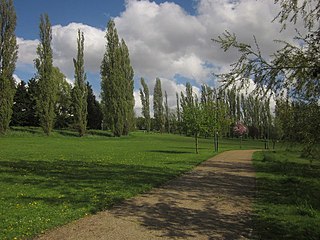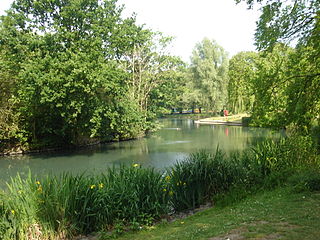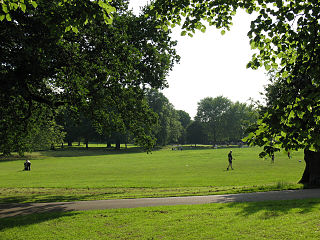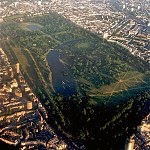
Blackheath is an area of South East London, England, straddling the border of the Royal Borough of Greenwich and the London Borough of Lewisham. It is located 1 mile north east of Lewisham, 1.5 miles south of Greenwich and 6.4 miles south east of Charing Cross, the traditional centre of London.

Mottingham is a district of south-east London, England, in the London Boroughs of Bromley and Greenwich. It is located south of Eltham, 9 miles southeast of Charing Cross. It is within the historic county of Kent.

Hither Green is a district in south-east London, England, in the London Borough of Lewisham. It forms the southern part of Lewisham, 6.6 miles (10.6 km) south-east of Charing Cross, and on the Prime Meridian.

Lee, also known as Lee Green, is a district of south east London, England, within the London Boroughs of Lewisham and Greenwich. It is located west of Eltham and east of Lewisham town centre. It is within the historic county of Kent.

Eltham is a district of southeast London, England, within the Royal Borough of Greenwich. It is 8.7 miles (14.0 km) east-southeast of Charing Cross, and is identified in the London Plan as one of 35 major centres in Greater London. The three wards of Eltham North, South and West have a total population of 35,459.

The River Quaggy is a river, 17 kilometres (11 mi) in length, passing through the south-east London boroughs of Bromley, Greenwich and Lewisham. In its lower reaches it is an urban river, in its upper reaches further from London it is more natural and known as the Kyd Brook. The river rises from two sources near Farnborough Hospital at Locksbottom and is a tributary of the River Ravensbourne which it flows into near Lewisham station in Lewisham.

Grove Park is a district of South East London, England within the London Borough of Lewisham. It is located north east of Bromley and south east of Lewisham.

Saint Anne's Park is a 240 acres (97 ha) public park situated between Raheny and Clontarf, suburbs on the northside of Dublin, Ireland. It is owned and managed by Dublin City Council.

Avenue House is a large Victorian mansion situated on East End Road in Finchley in the London Borough of Barnet.

Lewisham parks and open spaces are part of the "green lung" of London and include a diverse range of sites, from small urban parks and gardens to one of the most historic natural landscapes in Greater London at Blackheath. While overall control rests with London Borough of Lewisham, management of borough-owned parks and their facilities is contracted out to Glendale Grounds Management.

Chinbrook Meadows is a park in southeast London, England, one of Lewisham's public open spaces. It is located between Chinbrook and Grove Park in the London Borough of Lewisham adjacent to the boundary with the London Borough of Bromley. The park is within the SE12 postcode district, next to the border of the BR1 postcode district.

Pymmes Park is located in Edmonton, London and is bordered by the North Circular Road.

Dunorlan Park is a park and grounds in Royal Tunbridge Wells, UK.

Horn Park is an area of south east London south west of Eltham. It is located 12.5 km (7.8 mi) southeast of Charing Cross on the southwest edge of the Royal Borough of Greenwich and borders both the London Borough of Lewisham and the London Borough of Bromley. There is a public park also named Horn Park and two schools in the area. The River Quaggy flows northward though Horn Park, and the suburb is covered by the postcode district SE12, which was previously called the Lee postal district. There is community centre located in Horn Park Estate on Sibthorpe Road, that hosts a number of activities, such as Christian, council and MP meetings, and numerous classes including dance, karate and English.

Walpole Park is a 28 acres (110,000 m2) Grade II municipal park, situated in Ealing. Currently governed by Ealing Council, it was initially the grounds of Pitzhanger Manor, the early 19th-century country home of Sir John Soane. It was acquired by Ealing Council in 1899 and opened to the public for the first time on 1 May 1901. Within its boundaries are additional statutory protected structures: Pitzhanger Manor & Gallery and Lodge. Other attractions featured in its grounds include the late Victorian ornamental Serpentine Lake, bordering the House's rear lawn, and a pond further west with a pair of fountains – both of which attract waterfowl.

Springfield Park is a park in Upper Clapton in the London Borough of Hackney.

Avenue House Grounds is a ten-acre Site of Local Importance for Nature Conservation on East End Road in Church End, Finchley in the London Borough of Barnet. The estate is now known as Stephens House and Gardens.

Mayow Park, formerly known as Sydenham Recreation Ground, is a municipal park in London Borough of Lewisham. Located on Mayow Road in Sydenham, south east London, it is the borough's oldest park and its second oldest public open space after Blackheath. The park has a Green Flag Award.

Ladywell Fields, originally Ladywell Recreation Ground is a public park in the London Borough of Lewisham created from three historic fields. It is located near Ladywell railway station at the northern end of the park, and Catford Bridge at the southern end.

Boone's Chapel is a single-storey building attributed to Sir Christopher Wren and built in 1683. The chapel is very small, measuring just 45 square metres and is constructed of red brickwork with Portland stone details to window architraves, rusticated quoins and a pyramidal roof with an open wood cupola. The chapel is listed Grade I on the National Heritage List for England.
























